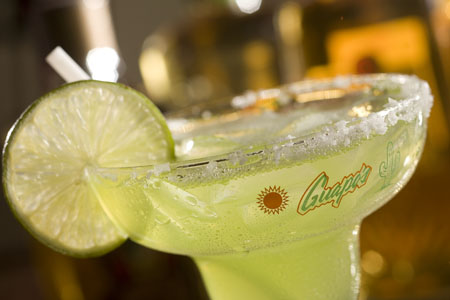The true origin of the martini is draped in mystery! There are differing arguments as to who was the first to create the Martini. Many who claim or have been purported to have created the first Martini have varying recipes and names; none of which exactly fit the Martini recipe that exists today. While opinions differ, the modern day Dry Martini consists of Gin and a varying amount of dry white Vermouth (season to taste). An olive, a twist, or a cocktail onion are all acceptable as a garnish.
The most detailed historical claim begins with a cocktail named the Martinez which was created around 1862. This particular drink of the time called for 4 parts red, sweet Vermouth to 1 part Gin, garnished with a cherry. The first version included aromatic bitters and Old Tom Gin, which was very sweet and incorporated a strong Juniper flavor. The transformation into what is considered a modern Martini happened gradually. First the Old Tom Gin was replaced with London Dry. Orange Bitters took the place of the aromatic bitters. Afficianados began to replace the red Vermouth with a white, dry Vermouth. The proportions of the drink eventually became equal parts and soon the Dry Martini appeared, olive included.
If you dont buy that story, perhaps some of these will win your favor.
In 1870 at Julio Richelieu's saloon in Martinez, California a small drink was mixed for visiting miner. Julio placed an olive in the glass before handing it to the man, then named it after his town. Martinez, California continues to hold claim as the birth place of the Martini.
Jerry Thomas of San Francisco printed a bartending book in 1887 with a Martinez recipe. It called for one dash of Bitters, two dashes of Maraschino, one wine glass of Vermouth, two jigs of ice and a pony of Old Tom Gin, served with a slice of lemon.
There is a story that claims the drink's name came from the Martini and Henry rifle used by the British army in 1871. The hook was that both the rifle and the drink "shared a strong kick."
In 1896, Thomas Stewart published Stewart's Fancy Drinks and How to Mix Them. The book contained a recipe for a drink called the "Marquerite" which called for "1 dash orange bitters, 2/3 Plymouth Gin, and 1/3 French Vermouth."
1888, was the magical year that the word Martini was first mentioned. Martini appeared in the "New and Improved Illustrated Bartending Manual."

Finally, in 1911 at the Knickerbocker Hotel in New York the head bartender, a gentleman by the name of Martini di Arma di Taggia, mixed half and half London Gin, Noilly Prat Vermouth and orange bitters. He chilled the drink on ice and strained it into a well chilled glass. Many visitors to the Knickerbocker asked for variations of the drink and added the olive.
Regardless of the true origin, the quest for the perfect Martini will no doubt continue. Martini bars continue to hit the scene -- and variations of the Martini abound. In the new millenium, it may seem that anything presented in a Martini Glas is considered to be a Martini. While that may or may not be true, we advise that you enjoy the moment! If it tastes good, it'll taste even better in a martini glass!
There are many versions of the Apple Martini, Appletini, or Big Apple Martini. Some use calvados, some apple puree, and some apple schnapps. This recipe uses the apple schnapps and has a very sweet taste and, depending on which brand you choose, will determine how bright of a green your drink will be. If you'd like to have a Sour Appletini, use Sour Apple Pucker. For an extra, edible touch to this drink, garnish with a green apple slice or peel.
How To Make An Apple Martini
How To Make An Apple Martini
Total Time: 2 minutes
Ingredients:
- 2 oz vodka
- 1 oz green-apple schnapps
Preparation:
- Pour the ingredients into a cocktail shaker with ice cubes.
- Shake well.
- Strain into a chilled cocktail glass.


 popular until the late
popular until the late